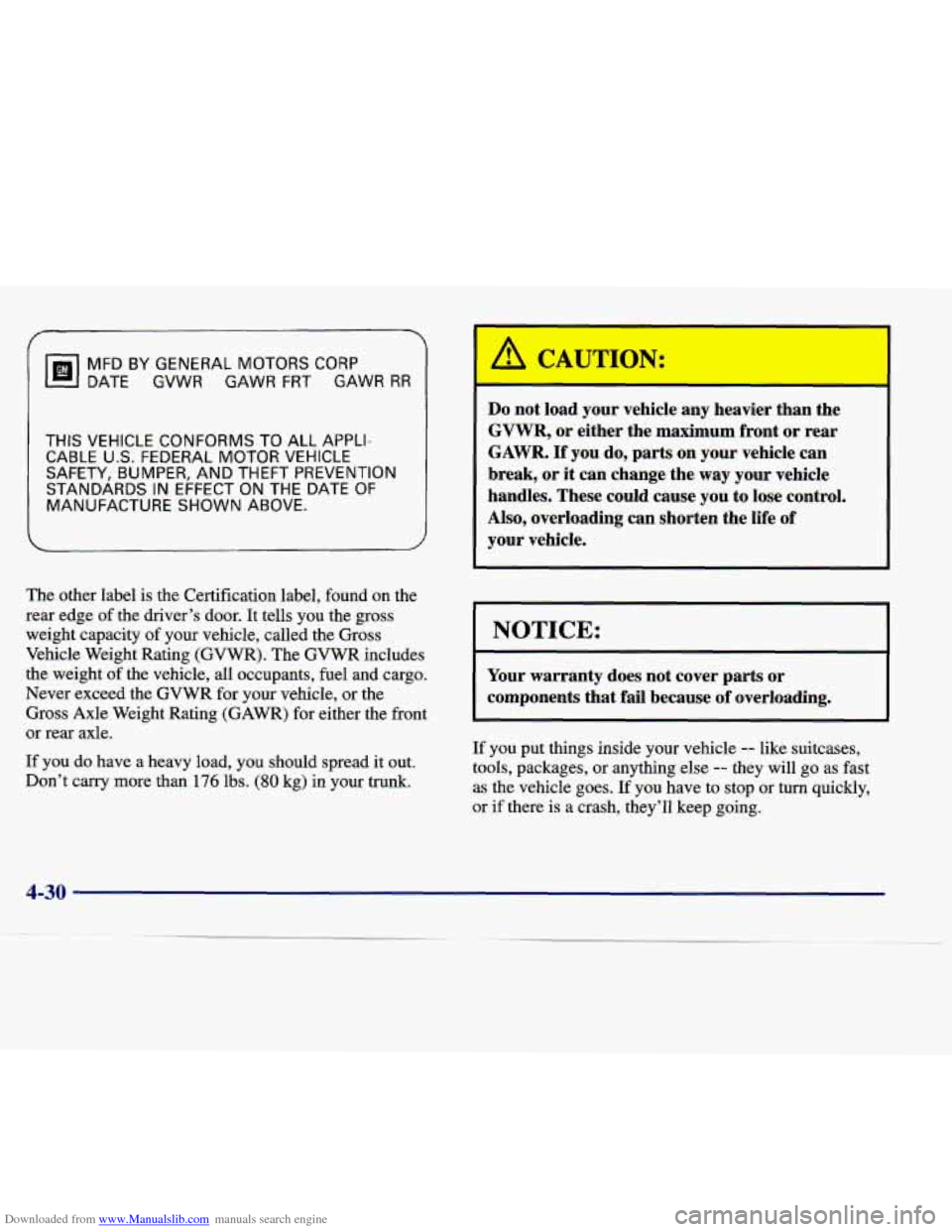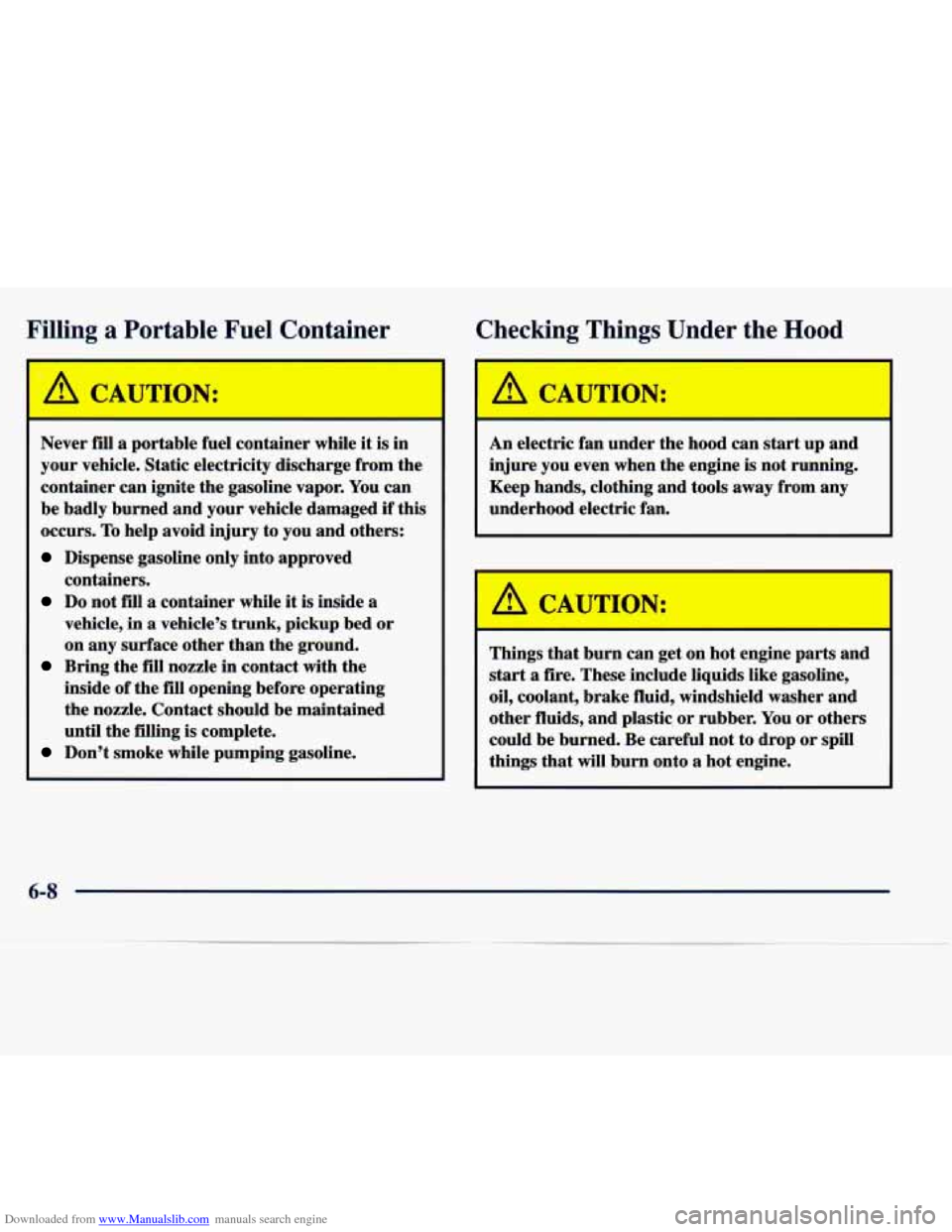Page 227 of 378

Downloaded from www.Manualslib.com manuals search engine /-
MFDBYGENERALMOTORSCORP DATE GVWR
GAWR FRT GAWR RR
THIS VEHICLE CONFORMS TO ALL APPLI-
CABLE
U.S. FEDERAL MOTOR VEHICLE
SAFETY,
BUMPER, AND THEFT PREVENTION
STANDARDS
IN EFFECT ON THE DATE OF
MANUFACTURE SHOWN ABOVE.
:
The other label is the Certification label, found on the
rear edge of
the driver’s door. It tells you the gross
weight capacity of your vehicle, called the Gross
Vehicle Weight Rating
(GVWR). The GVWR includes
the weight of the vehicle, all occupants, fuel and cargo.
Never exceed the GVWR for your vehicle, or the
Gross Axle Weight Rating (GAWR) for either the front
or rear axle.
If you do have a heavy load, you should spread
it out.
Don’t carry more than
176 lbs. (80 kg) in your trunk.
Do not load your vehicle any heavier than the
GVWR, or either the maximum front or rear
GAWR.
If you do, parts on your vehicle can
break, or it can change the
way your vehicle
handles. These could cause you to lose control.
Also, overloading can shorten the life
of
your vehicle.
NOTICE:
Your warranty does not cover parts or
components that fail because
of overloading.
If you put things inside your vehicle -- like suitcases,
tools, packages, or anything else
-- they will go as fast
as the vehicle goes.
If you have to stop or turn quickly,
or
if there is a crash, they’ll keep going.
4-30
Page 228 of 378

Downloaded from www.Manualslib.com manuals search engine 1 A CAUTION:
Things you put inside your vehicle can strike
and injure people in a sudden stop or turn,
or
in a crash.
Put things in the trunk of your vehicle. In a
trunk, put them as
far forward as you can.
Try to spread the weight evenly.
inside the vehicle
so that some of them are
above the tops of the seats.
Don’t leave an unsecured child restraint in
your vehicle.
When you carry something inside the
vehicle, secure it whenever
you can.
Never stack heavier things, like suitcases,
Electronic Level Control
This feature keeps the rear of your vehicle level as
the load changes. It’s automatic
-- you don’t need to
adjust anything.
Towing a Trailer
A CAUTION:
If you don’t use the correct equipment and drive
properly, you can lose control when you pull a
trailer. For example, if the trailer is too heavy,
the brakes may not work well
-- or even at all.
You and your passengers could be seriously
injured. You may also damage your vehicle; the
resulting repairs would not be covered by your
warranty. Pull
a trailer only if you have followed
all the steps in this section. Ask your dealer for
advice and information about towing a trailer
with your vehicle.
Your vehicle can tow a trailer if it is equipped with the
proper trailer towing equipment.
To identify what the
vehicle trailering capacity
is for your vehicle, you
should read the information in “Weight of the Trailer”
that appears later in this section. But trailering is
different than just driving your vehicle
by itself.
4-31
~~
Page 262 of 378
Downloaded from www.Manualslib.com manuals search engine The following steps will tell you how to use the jack and
change a tire.
Removing the Spare Tire and Tools
The equipment you’ll need is in the trunk.
Instructions for changing your tires are on the inside of
the tire cover.
To lift the tire cover to gain access to the spare tire and
jacking equipment, do the following:
1. Press the area at the
front of the handle
so
that the back edge
swings upward.
5-25
Page 263 of 378
Downloaded from www.Manualslib.com manuals search engine I 2. Grab the handle and
remove the cover.
Unscrew the wing nuts
to remove the container that
holds the wrench and jack.
Remove the wheel wrench, jack and spare tire from
the trunk.
5-26
Page 270 of 378

Downloaded from www.Manualslib.com manuals search engine NOTICE:
Improperly tightened wheel nuts can lead to
brake pulsation and rotor damage.
To avoid
expensive brake repairs, evenly tighten the wheel
nuts in the proper sequence and to the proper
torque specification.
Don’t try to put a wheel cover on your compact spare
tire.
It won’t fit. Store the wheel cover and lug nut caps
in the trunk until you have the flat tire repaired
or replaced.
I NOTICE:
Wheel covers won’t fit on your compact. spare. If
you try to put a wheel cover on your compact
spare, you could damage the cover or the spare.
Storing the Flat Tire and Tools
,A CAUTION:
Storing a jack, a tire or other equipment in the
passenger compartment
of the vehicle could
cause injury. In
a sudden stop or collision, loose
equipment could strike someone. Store all these
in the proper place.
After you’ve put the compact spare tire on your vehicle,
you’ll need to store the flat tire in your trunk.
Store the flat tire as far forward in the trunk as possible.
Store the jack and wheel wrench in their compartment in
the trunk. For storage, the
jack must be raised until the
screw end is flush with the edge of the jack.
5-33
.~ .~
Page 271 of 378
Downloaded from www.Manualslib.com manuals search engine Storing the Spare Tire and Tools
' A CAUTIC J:
Storing a jack, a tire or other equipment in the
passenger compartment
of the vehicle could
cause injury. In
a sudden stop or collision, loose
equipment could strike someone. Store all these
in the proper place.
The compact spare is for temporary use only. Replace
the compact spare tire with
a full-size tire as soon as you
can. See the storage instructions label to replace your
compact spare
into your trunk properly.
A
SPARE TIRE COVER
5-34
Page 281 of 378
Downloaded from www.Manualslib.com manuals search engine To open the fuel door, push
the fuel release button
located below the light
controls under the instrument
panel on the left-hand side.
The vehicle must be in
PARK (P) or NEUTRAL (N)
and the valet lock switch
must be
off.
An alternate fuel door
release is located inside of
the
trunk on the left-hand
side. Pull it to release the
fuel door.
f
While refueling, hang the cap by the tether from the
hook on
the filler door.
To remove the cap, turn it slowly to the left
(counterclockwise). The cap has a spring in
it; if you let
go of the cap too soon, it will spring back to the right.
6-6
Page 283 of 378

Downloaded from www.Manualslib.com manuals search engine "illinr a T--table Fuel Cont-iner Checking Things
Und -T the I'3od
m--
Never fill a portable fuel container while it is in
your vehicle. Static electricity discharge from the
container can ignite the gasoline vapor. You can
be badly burned and your vehicle damaged
if this
occurs. To help avoid injury to you and others:
Dispense gasoline only into approved
containers.
Do not fill a container while it is inside a
vehicle, in
a vehicle's trunk, pickup bed or
on any surface other than the ground.
inside of the fill opening before operating
the nozzle. Contact should be maintained
until the filling is complete.
Bring the fill nozzle in contact with the
Don't smoke while pumping gasoline. An
electric fan under the hood can start up and
injure you even when the engine
is not running.
Keep hands, clothing and tools away from any
underhood electric fan.
A CAUTION:
Things that burn can get on hot engine parts and
start
a fire. These include liquids like gasoline,
oil, coolant, brake fluid, windshield washer and
other fluids, and plastic or rubber. You or others
could be burned.
Be careful not to drop or spill
things that will burn onto a hot engine.
6-8